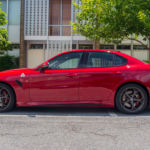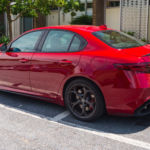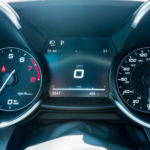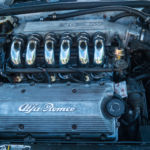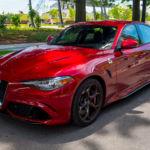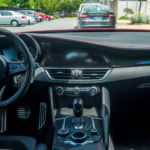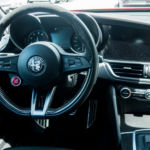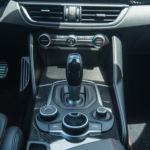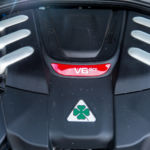It’s fair to say that I’d been looking forward to getting behind the wheel of the Alfa Romeo Giulia Quadrifoglio for some time. The brand’s new flagship sedan is a $72,000, 505hp (377kW) rear-wheel drive statement of intent, a car that says to rivals at BMW and Mercedes and Cadillac that the Italians are back. It first caught our attention at the 2015 Frankfurt Motor Show, then again in Los Angeles. Last year, the Giulia Quadrifoglio teased us some more in New York 2016 and then once again this year when we awarded it Best New Luxury Car. But a build-up like that can be risky. Cars don’t always meet our expectations, and there’s little worse than the feeling when you fail to gel with a car you’ve been looking forward to driving.
A man on a TV show once said something along the lines of “you can’t consider yourself a true petrolhead until you’ve had an Alfa Romeo.” At the time, I wasn’t entirely sure what he was talking about. The Alfas that populated the roads during my early driving years in the 1990s were unremarkable and badly compromised. During the 2000s, they were pretty but almost exclusively front-driven. And the Giulietta rental car I crossed Europe in a few years back had the most amazingly uncomfortable driving seat I’d ever encountered.
Well, forget all thatif the new Giulia Quadrifoglio is anything to go by, the brand is back. I’ll go one further: if Ferrari were going to build a rival to the BMW M3, it would be this car. The new Giulia Quadrifoglio is just wonderful.
Whats the Italian for tech transfer?”
Ferrari is no longer owned by the same Fiat Chrysler Automobiles parent company as Alfa Romeo, but there is more than a little evidence of close familial links between the cars that wear the prancing horse badge and this Alfa with its (hand-enameled) four leaf clovers. Like the engine. It’s an all-aluminum 90-degree, twin-turbo 2.9L V6 with direct injection and even cylinder deactivation for better performance and economy. The engine is also extremely similar to the all-aluminum, 90-degree, twin-turbo 3.8L V8s (codenamed F154) you’d find powering a Ferrari 488 or California T. That’s not a bad thing at all.
Chopping two cylinders out of the F154 doesn’t seem to have done it any harm. The engine has a peak power output of 505hp (377kW) at 6,500 rpm and a typically turbocharged torque curve that’s flat at 443lb-ft (600Nm) between 2,500 and 5,500rpm. And while the tachometer redlines at 6,500rpm, the engine will actually keep going for another 900rpm.
Here in the US, we have only a single choice of gearboxZF’s extremely good 8HP75. Some might bemoan the lack of a three-pedal option, but from what we’ve read of Europeans’ experience with the manual gearbox, Alfa made the right choice. After all, you can’t buy a Ferrari with three pedals these days, can you? The eight-speed sends all the power and torque to the rear wheels via a carbon fiber propshaftyes, like you might buy in Gran Turismo once you’ve run out of other things to spend money onand then to a torque-vectoring rear differential. (It’s a twin-clutch affair similar to the diff you find in the Ford Focus RS or those Audis with an R in the badge.)
The suspension uses double wishbones up front and a multilink arrangement at the rear, with active dampers that are continuously controlled by the car’s brain, known in Alfa-speak as the Chassis Domain Controller. The brakes are hefty Brembos; at the front 14.2 inches (360mm) with six-piston calipers, at the rear 13.8 inches (350mm) with four-piston calipers. (Carbon ceramics are available as an option but weren’t fitted to our test car.) Alfa says that the Giulia Quadrifoglio is the first car to feature an integrated brake system that replaces “a traditional system of electronic stability control (ESC) unit and brake booster for even more instantaneous braking response.”
The extensive use of aluminum in the chassis and suspension keeps weight down to around 3,360lb (1,524kg). That’s split 50:50 over the front and rear axles for better handling, and Alfa claims a class-leading almost seven lbs:hp power-to-weight ratio.
All of the Alfa’s technogubbins are wrapped up into our eyes at leasta stunning exterior. Alfa hasn’t been stingy with the carbon fiber. The Quadrifoglio’s hood and roof are both carbon fiber, and you can even see the naked weave of the former underneath the cowl when you’re sitting in either front seat. Naked carbon fiber also adorns the front splitter, the rear spoiler, and the side sills.
You detect more Ferrari influence in the aerodynamics of the Quadrifoglio. It’s not just the scoops and ducts that adorn the front bumper and hoodthat carbon front splitter (which drops down at speed and generates 220lbs of downforce at the front) and that rather hefty rear diffuser at the back have some Ferrari DNA, too.
Tell me why I shouldnt just buy an M3
OK, that’s enough with the technical specs and the re-writing of Alfa’s press kit. What you really want to know is why you should care about the Giulia Quadrifoglio, and care about it you should if you like fast, practical cars that sound amazing, look the business, and drive well. Don’t get me wrongthe car is not perfect. In fact, as you’ll see in the video, the Quadrifoglio has plenty of little flaws here and there. But this car truly is more than the sum of its parts.
Climb in through the door and drop yourself into the driver’s seat. At first, you find you’re sitting much too far back in the chassis, but that fixes itself with a push of the big red start button on the steering wheel. Soon, the dials flair to life and the seat moves itself closer to the pedals and wheel.
A quick look around the cabin reveals a few things. The design theme is more than a little Ferrari-like; from the contrast stitching, circular air vents, and lashings of carbon fiber, to the hooded instrument binnacles, massive aluminum shift paddles, and that narrow (carbon fiber) steering wheel rim.
The seats themselves are extremely good, electrically adjustable every which-way and capable of hugging you tight with the massive side bolsters. (Carbon-fiber buckets are one of the few options on the Quadrifoglio, but we don’t think you really need them.) The ergonomics are great for the most part. Unlike Ferrari, the steering wheel isn’t totally covered in buttons and dials, but the switchgear is located logically, with the exception of the infotainment jog wheel, which you might well disturb if you use the gear lever while driving somewhere in an ebullient and Italianate fashion. (With the exception of one of our testers, this is something you’d never do, because those huge flappy paddles are sublime to use.)
With the engine running, you’ll also notice something elseyour seat vibrates. With the engine on and ticking over, the entire car fizzes with excitement. Now, if you were an engineer from BMW or Mercedes or Cadillac, you’d call this NVH (noise, vibration, and harshness), and you’d add dampers and bushings and change engine mounts and so on until that all went away. But the folks at Alfa rightly saw this as proof of the car’s character and left it well alone. Good for them!
Once you’ve selected a gear and are on the move, another thing quickly becomes apparent. There’s tons of feel through the steering, which is extremely quick and directanother recent Ferrari trait. It’s not a variable ratio system, just good old-fashioned rack and pinion, although the amount of electrical assist you get varies depending upon the mode you’re in, of which there are four.
Listing image by Jonathan Gitlin

